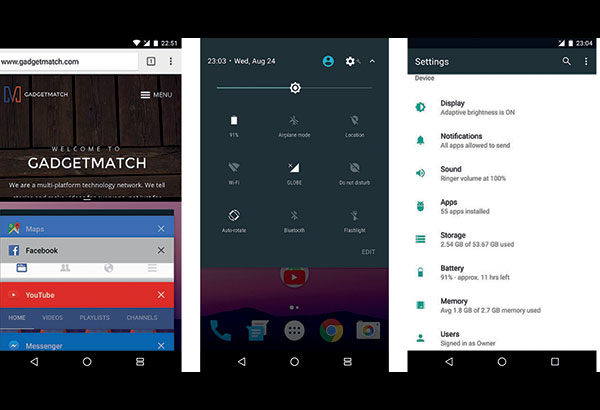Nougat is Android’s best, but there’s still room for improvement
MANILA, Philippines - It’s been nearly two months since Google officially named the seventh version of its Android operating system, and we’re now seeing Nexus devices receiving Android 7.0 Nougat through direct, over-the-air downloads.
It’s a given that this is the most mature and jampacked iteration of any Google-powered OS to date, but how far has it come along?
Having spent a substantial amount of time on both the beta phase and the stable build we have now, we must say that Nougat is by far the most efficient Android version to ever grace a handset. It’s obvious how Google took some inspiration from manufacturers.
Software features that have been present on Samsung, HTC and Sony smartphones, among others, have become part of Android’s most basic interface.

Everything is simply better
Multitasking, for one, is a headline feature of Nougat. Google took a page out of Samsung’s book and applied split-screen multitasking as a standard function. But unlike Samsung’s limited take on the feature, Nougat’s implementation is compatible with far more applications.
By opening any app and holding the app overview button (the square to the right of the circular home button), you’re shown a list of recent apps to display on the lower half of the screen. And this isn’t some lame, laggy feature either; for instance, you can watch a full-length video while taking notes on your app of choice.
On the subject of efficiency, tapping the same overview button twice will allow you to switch to the last app you accessed. Think of it as a “Command + Tab” (on a Mac) or “Alt + Tab” (on Windows) shortcut for Android. We found this especially useful for going through multiple chat apps with less touches and swipes.
Another vital improvement is the smarter notifications and settings. In addition to the greater control you have over the notifications you receive, such as instantly sharing or replying from the alert itself, quick settings are available on the first swipe down from the top. Swipe once more, and you’ll see a longer list of settings, all of which can be rearranged or swapped for whatever you find more fitting.
As for the main settings menu, you’re greeted with a preview for each option; you can see how much space you have without entering the “Storage” setting, and even preview your data and battery usage without entering the sub-menu.
And these are just some of our favorite new features of Nougat. Expect longer battery life, stronger security, an additional set of 72 emoji to play with, and greater control over the data usage of specific apps, to name a few, once Android 7.0 Nougat enters your gadget.
But all’s not well
Like any operating system fresh out of the lab, there are growing pains to deal with. Besides a couple of bugs we encountered on our updated Nexus 6P, such as the battery percentage meter constantly disappearing and Google Now sometimes crashing, not all design cues and features work the way they should.
The most glaring issue is app compatibility during split-screen multitasking. While it’s understandable that a large helping of third-party software aren’t ready for the cut-up interface, it’s inexcusable for the built-in apps Google produced themselves. A message that the “App may not work with split-screen” appears on apps like YouTube, and to make matters worse, you’ll see “App doesn’t support split-screen” for the basic Google Search app. Fortunately, time is the cure for this, since this function is now baked into the core of Android.
Interestingly, the “Clear All” button is now back in the app overview, despite Android developers claiming it’s unnecessary because of better memory management since 5.0 Lollipop. The bad news is that it’s found at the very top of the app list, meaning you have to scroll through every open app to reach the option. Nougat is already excellent at keeping programs in a low-power state when not in use, but for clean freaks, having instant access to the clear button would have been glorious.
Lastly – and this has been prevalent for a few Android generations now – you still can’t add widgets or apps to the left of the primary home screen. Everything simply goes to the right, so if you’re a fan of multiple widgets, you have only one direction to swipe for quick access.
Don’t hold your breath, unless you’re a Nexus user
What use is software if you can’t experience it? Unless you own a Nexus device, chances are you’re not receiving a Nougat update anytime soon. Google’s very own devices always get first dibs on major updates, while other users could wait as long as a year for just a hint of good news. Things could be changing, however, with news of the upcoming LG V20 being the first smartphone to come equipped with the latest Android version straight out of the box, and not a next-generation Google Nexus. With this, Google might finally be addressing its most recurring issue: fragmentation.
Android’s fragmentation, which refers to the overly diverse range of versions across all smartphones and tablets, is currently at its worst. Looking at the chart above, which hasn’t even been updated to reflect the latest Android version yet, shows how last year’s 6.0 Marshmallow continues to catch up with the wider distribution of older generations, despite Android 7.0 Nougat already being available.
Still, possibly poor market share shouldn’t put down Nougat’s accomplishments. Consider yourself lucky if you’re part of the new minority of Nougat users; it’s as solid as it gets for Android.
- Latest





























